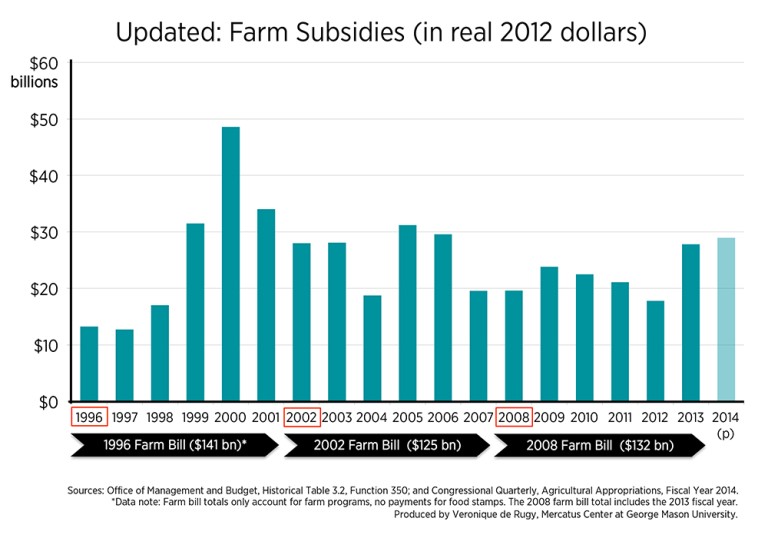- | Government Spending Government Spending
- | Data Visualizations Data Visualizations
- |
Updated: The History of Farm Bill Spending
This week’s chart updates the history of government subsidies to the agriculture industry from 1996 to the present, using data from the Office of Management and Budget as well as new spending projections indicated by the 2014 Omnibus Bill.

This week’s chart updates the history of government subsidies to the agriculture industry from 1996 to the present, using data from the Office of Management and Budget as well as new spending projections indicated by the 2014 Omnibus Bill.
The farm bill typically comes up for renewal every five years, although technical considerations prevented legislators from passing the expected farm bill in 2013. The bill’s specific provisions determine whether and to what extent major farm programs administered by the US Department of Agriculture (USDA) will continue to be publicly funded. It is important to put the history of farm bill spending in proper context as Congress considers a revamped reauthorization of the farm bill this January.

According to the Congressional Research Service (CRS), the five-year cost (FY2008–2012) of major farm support programs was projected at $83 billion, an average of $16 billion per year when the 2008 farm bill was enacted. CRS’s updated estimates in 2010 showed a higher five-year cost of $87 billion, an annual average of $17 billion. Congress was unable to reauthorize a farm bill in 2012 before the program expired, instead passing a temporary extension to fund agricultural programs for another nine months. The White House budget, therefore, shows that spending for farm subsidies during this most recent period is closer to $104 billion, an average of $21 billion per year.
A CRS analysis of the defeated 2013 farm bill finds that the ten-year cost (FY2014–2013) would be almost $1 trillion in total, $195 billion of which would be earmarked for agricultural special interests, amounting to an average of $19.5 billion per year. If the overly optimistic projections of the 2008 farm bill are any guide, the promised expenditures of the eventual farm bill may be underestimates.
Such sizable spending attracts attention: more available money creates more opportunities for special interest groups and lobbying. In 2010, 10 percent of farms received 74 percent of all subsidies. Moreover, with farm household incomes 53 percent higher than the average US household income in 2012, farm subsidies amount to corporate welfare for the relatively well off.
The farm bill’s unjust and unnecessary privileges given to the agricultural industry have grown too unjustifiable to ignore. What was once essentially a recurring rubber-stamp subsidy is now the focus of scrutiny and growing calls for reform from citizen watchdog groups. This rising opposition to farm bill corporatism contributes to congressional inability to customarily reauthorize these sweetheart programs since the 2008 farm bill expired in the fall of 2012. Congress must heed this new resistance. Instead of passing temporary authorizations to delay the inevitable, Congress should put an end to farm subsidies and to other preferential treatments that farmers have received for decades.
Data note: The original version of this chart stated that farm household incomes were 25 percent higher than the average household income. This statement was true in 2011, but has since been updated with new data for 2012.